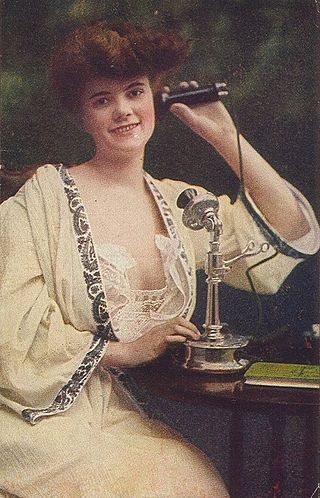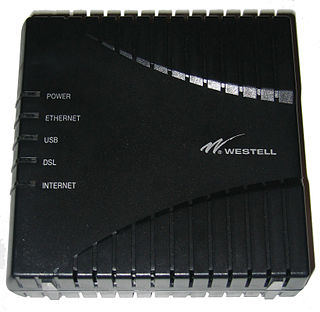
A bulletin board system (BBS), also called a computer bulletin board service (CBBS), is a computer server running software that allows users to connect to the system using a terminal program. Once logged in, the user performs functions such as uploading and downloading software and data, reading news and bulletins, and exchanging messages with other users through public message boards and sometimes via direct chatting. In the early 1980s, message networks such as FidoNet were developed to provide services such as NetMail, which is similar to internet-based email.

Dual-tone multi-frequency signaling (DTMF) is a telecommunication signaling system using the voice-frequency band over telephone lines between telephone equipment and other communications devices and switching centers. DTMF was first developed in the Bell System in the United States, and became known under the trademark Touch-Tone for use in push-button telephones supplied to telephone customers, starting in 1963. DTMF is standardized as ITU-T Recommendation Q.23. It is also known in the UK as MF4.

In telecommunications, an acoustic coupler is an interface device for coupling electrical signals by acoustical means—usually into and out of a telephone.
The Telephony Application Programming Interface (TAPI) is a Microsoft Windows API, which provides computer telephony integration and enables PCs running Microsoft Windows to use telephone services. Different versions of TAPI are available on different versions of Windows. TAPI allows applications to control telephony functions between a computer and telephone network for data, fax, and voice calls. It includes basic functions, such as dialing, answering, and hanging up a call. It also supports supplementary functions, such as hold, transfer, conference, and call park found in PBX, ISDN, and other telephone systems.

Dial-up Internet access is a form of Internet access that uses the facilities of the public switched telephone network (PSTN) to establish a connection to an Internet service provider (ISP) by dialing a telephone number on a conventional telephone line which could be connected using an RJ-11 connector. Dial-up connections use modems to decode audio signals into data to send to a router or computer, and to encode signals from the latter two devices to send to another modem at the ISP.

The Hayes command set is a specific command language originally developed by Dale Heatherington and Dennis Hayes for the Hayes Smartmodem in 1981.

A blue box is an electronic device that produces tones used to generate the in-band signaling tones formerly used within the North American long-distance telephone network to send line status and called number information over voice circuits. During that period, charges associated with long-distance calling were commonplace and could be significant, depending on the time, duration and destination of the call. A blue box device allowed for circumventing these charges by enabling an illicit user, referred to as a "phreaker," to place long-distance calls, without using the network's user facilities, that would be billed to another number or dismissed entirely by the telecom company's billing system as an incomplete call. A number of similar "color boxes" were also created to control other aspects of the phone network.

A telephone call or telephone conversation, also known as a phone call or voice call, is a connection over a telephone network between the called party and the calling party. Telephone calls started in the late 19th century. As technology has improved, a majority of telephone calls are made over a cellular network through mobile phones or over the internet with Voice over IP. Telephone calls are typically used for real-time conversation between two or more parties, especially when the parties cannot meet in person.
In telecommunications, in-band signaling is the sending of control information within the same band or channel used for data such as voice or video. This is in contrast to out-of-band signaling which is sent over a different channel, or even over a separate network. In-band signals may often be heard by telephony participants, while out-of-band signals are inaccessible to the user. The term is also used more generally, for example of computer data files that include both literal data, and metadata and/or instructions for how to process the literal data.
Guard tone is a feature of wireline modems.
Hayes Microcomputer Products was a US-based manufacturer of modems. The company is known for the Smartmodem, which introduced a control language for operating the functions of the modem via the serial interface, in contrast to manual operation with front-panel switches. This smart modem approach dramatically simplified and automated operation. Today almost all modems use a variant of the Hayes command set.

A digital subscriber line (DSL) modem is a device used to connect a computer or router to a telephone line which provides the digital subscriber line (DSL) service for connection to the Internet, which is often called DSL broadband. The modem connects to a single computer or router, through an Ethernet port, USB port, or is installed in a computer PCI slot.

Novation, Inc., is an early modem manufacturer whose CAT series were popular in the early home computer market in the late 1970s and early 1980s, notably on the Apple II. The Hayes Smartmodem 300, introduced in 1981, helped kill off Novation and many other early modem companies over the next few years.
Command mode and Data mode refers to the two modes in which a computer modem may operate. These modes are defined in the Hayes command set, which is the de facto standard for all modems. These modes exist because there is only one channel of communication between the modem and the computer, which must carry both the computer's commands to the modem, as well as the data that the modem is enlisted to transmit to the remote party over the telephone line.
In telecommunication, supervision is the monitoring of a telecommunication circuit for telephony to convey to an operator, user, or a switching system, information about the operational state of the circuit. The typical operational states of trunks and lines are the idle and busy states, seizure, and disconnect. The states are indicated by various electrical signals and electrical conditions depending on the type of circuit, the type of terminating equipment, and the type of intended service.
A voice modem is an analog telephone data modem with a built-in capability of transmitting and receiving voice recordings over the phone line. Voice modems are used for telephony and answering machine applications. Similar to the Hayes command set used for data modems, in which the host PC commands the modem via a series of commands known as AT commands, there exists a well-defined set of common voice AT commands that are somewhat consistent throughout the industry.
Data Carrier Detect (DCD) or Carrier Detect (CD) is a control signal present inside an RS-232 serial communications cable that goes between a computer and another device, such as a modem. This signal is a simple "high/low" status bit that is sent from a data communications equipment (DCE) to a data terminal equipment (DTE), i.e., from the modem or other peripheral to a computer in a typical scenario. It is present on virtually all PC serial ports - pin 1 of a nine-pin (DE9) serial port, or pin eight over a 25-pin (DB25) port. Its purpose varies depending on the device connected, but the most specific meaning is to indicate when a modem is connected to another remote modem via telephone lines.

A modulator-demodulator, commonly referred to as a modem, is a computer hardware device that converts data from a digital format into a format suitable for an analog transmission medium such as telephone or radio. A modem transmits data by modulating one or more carrier wave signals to encode digital information, while the receiver demodulates the signal to recreate the original digital information. The goal is to produce a signal that can be transmitted easily and decoded reliably. Modems can be used with almost any means of transmitting analog signals, from light-emitting diodes to radio.
Data Terminal Ready (DTR) is a control signal in RS-232 serial communications, transmitted from data terminal equipment (DTE), such as a computer, to data communications equipment (DCE), for example a modem, to indicate that the terminal is ready for communications and the modem may initiate a communications channel.

A mobile broadband modem, also known as wireless modem or cellular modem, is a type of modem that allows a personal computer or a router to receive wireless Internet access via a mobile broadband connection instead of using telephone or cable television lines. A mobile Internet user can connect using a wireless modem to a wireless Internet Service Provider (ISP) to get Internet access.











